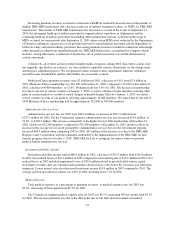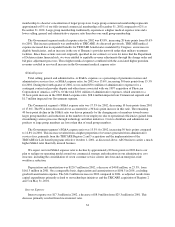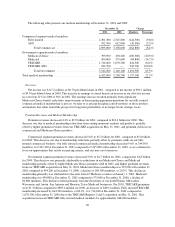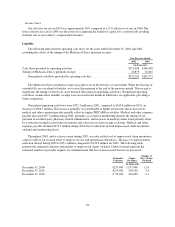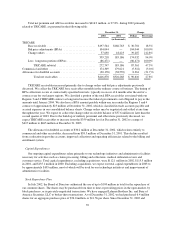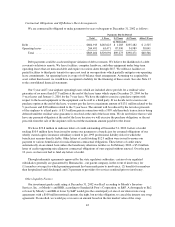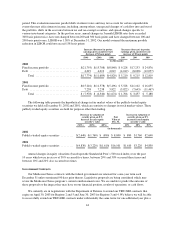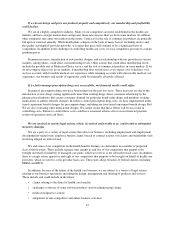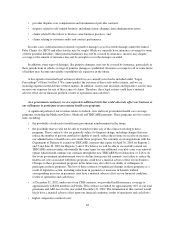Humana 2002 Annual Report Download - page 49
Download and view the complete annual report
Please find page 49 of the 2002 Humana annual report below. You can navigate through the pages in the report by either clicking on the pages listed below, or by using the keyword search tool below to find specific information within the annual report.agreement. Assuming this swap agreement had been cancelled on December 31, 2002, we would have received
$34.9 million. Other than the swap agreement, adverse changes in our credit ratings will not create, increase, or
accelerate any liabilities. Adverse changes in our credit rating will increase the rate of interest we pay and may
impact the amount of credit available to us in the future.
Related Parties
No related party transactions had a material effect on our financial position, results of operations or cash
flows. Certain immaterial related party transactions are discussed in our Proxy Statement for the meeting to be
held May 15, 2003 – see “Certain Transactions with Management and Others.”
Regulatory Requirements
Certain of our subsidiaries operate in states that regulate the payment of dividends, loans or other cash
transfers to Humana Inc., our parent company, require minimum levels of equity, and limit investments to
approved securities. The amount of dividends that may be paid to Humana Inc. by these subsidiaries, without
prior approval by state regulatory authorities, is limited based on the entity’s level of statutory income and
statutory capital and surplus. In most states, prior notification is provided before paying a dividend even if
approval is not required.
As of December 31, 2002, we maintained aggregate statutory capital and surplus of $1,006.9 million in our
state regulated health insurance subsidiaries. Each of these subsidiaries was in compliance with applicable
statutory requirements which aggregated $576.0 million. Although the minimum required levels of equity are
largely based on premium volume, product mix, and the quality of assets held, minimum requirements can vary
significantly at the state level. Certain states rely on risk-based capital requirements, or RBC, to define the
required levels of equity. RBC is a model developed by the National Association of Insurance Commissioners to
monitor an entity’s solvency. This calculation indicates recommended minimum levels of required capital and
surplus and signals regulatory measures should actual surplus fall below these recommended levels. Some states
are in the process of phasing in these RBC requirements over a number of years. If RBC were fully implemented
by all states at December 31, 2002, each of our subsidiaries would be in compliance, and we would have
$358.8 million of aggregate capital and surplus above the minimum level required under RBC.
One TRICARE subsidiary under the Regions 3 and 4 contract with the Department of Defense is required to
maintain current assets at least equivalent to its current liabilities. We were in compliance with this requirement
at December 31, 2002.
Future Liquidity Needs
We believe that funds from future operating cash flows and funds available under our credit agreements and
commercial paper program are sufficient to meet future liquidity needs. We also believe these sources of funds
are adequate to allow us to fund selected expansion opportunities, as well as to fund capital requirements.
Market Risk-Sensitive Financial Instruments and Positions
The level of our pretax earnings is subject to risk due to changes in investment income from our fixed
income portfolio which is partially offset by both our debt position and the short-term duration of the fixed
income investment portfolio.
We evaluated the impact on our investment income and debt expense resulting from a hypothetical change
in interest rates of 100, 200 and 300 basis points over the next twelve-month period, as reflected in the following
table. The modeling technique used to calculate the pro forma net change considered the cash flows related to
fixed income investments and debt, which are subject to interest rate changes during a prospective twelve-month
43


